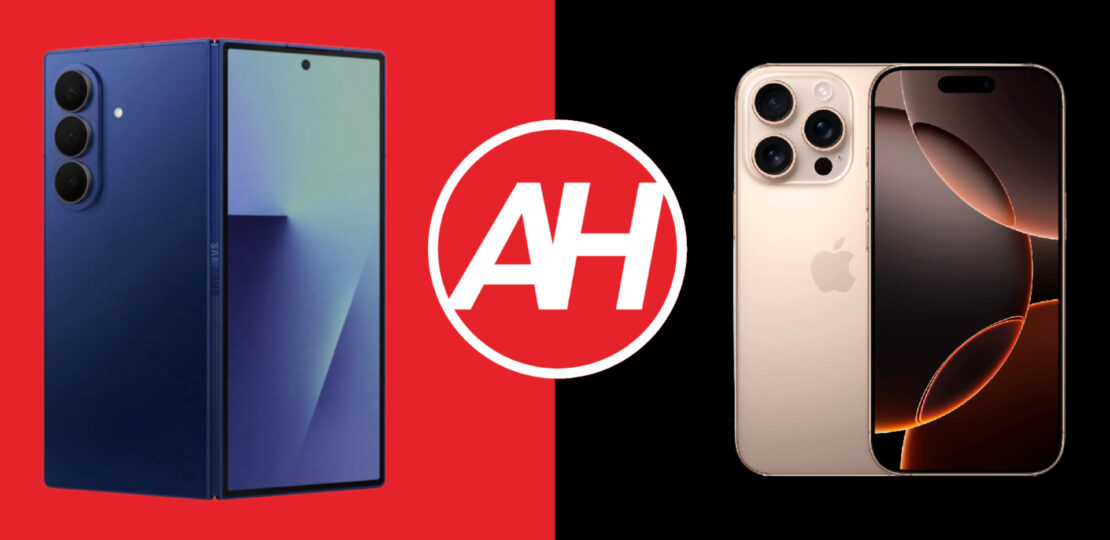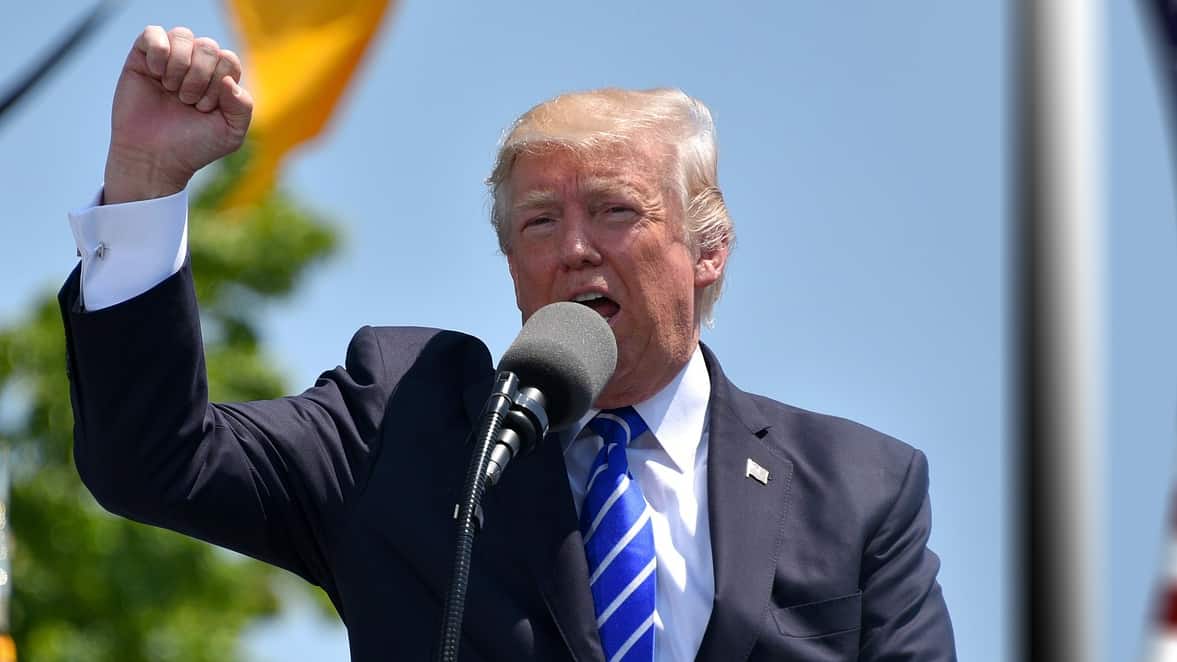
We’ve recently compared Samsung’s new flagship foldable with the best large phone Apple has to offer now. Well, now, it’s time to do something similar. We’ll be comparing the Samsung Galaxy Z Fold 7 vs Apple iPhone 16 Pro. A foldable vs a compact non-foldable flagship, which should be a rather interesting comparison. These two phones are vastly different, needless to say.
As per usual, we will first list the specs both smartphones offer, and will then jump to comparing their designs, displays, performance, battery life, cameras, and audio output. This is a rather weird comparison considering monumental differences between these two devices, but that’s what makes it interesting. Let’s get to it, shall we?
Specs

Samsung Galaxy Z Fold 7

Apple iPhone 16 Pro
| Samsung Galaxy Z Fold 7 | Apple iPhone 16 Pro | |
|---|---|---|
| Dimensions (unfolded/folded) | 158.4 x 143.2 x 4.2mm / 158.4 x 72.8 x 8.9mm | 149.6 x 71.5 x 8.3 mm |
| Weight | 215 grams | 199 grams |
| Main display | 8-inch Dynamic AMOLED 2X (1-120Hz) | 6.3-inch LTPO Super Retina XDR OLED (1-120Hz) |
| Cover display | 6.5-inch Dynamic AMOLED 2X (1-120Hz) | N/A |
| Resolution | 2184 x 1968 / 2520 x 1080 | 2622 x 1206 |
| Chipset | Qualcomm Snapdragon 8 Elite for Galaxy | Apple A18 Pro |
| RAM | 12GB (LPDDR5X) | 8GB |
| Storage | 256GB/512GB (UFS 4.0) | 128GB/256GB/512GB/1TB (NVMe) |
| Main camera | 200MP (f/1.7 aperture, OIS, Quad Pixel AF, 0.6um pixel size, 85-degree FoV) | 48MP (wide, f/1.8 aperture, 1/1.28-inch sensor size, 1.22um pixel size, dual pixel PDAF, sensor-shift OIS) |
| Ultra-wide camera | 12MP (f/2.2 aperture, Dual Pixel AF, 1.4um pixel size, 120-degree FoV) | 48MP (f/2.2 aperture, 1/2.55-inch sensor size, 0.7um pixel size, PDAF) |
| Telephoto camera | 10MP (f/2.4 aperture, PDAF, 36-degree FoV, 3x optical zoom) | N/A |
| Periscope camera | N/A | 12MP (f/2.8 aperture, 1/3.06-inch sensor size, 1.12um pixel size, dual pixel PDAF, 3D sensor-shift OIS, 5x optical zoom) |
| Selfie camera(s) | 10MP (f/2.2 aperture, 1.12um pixel size, 85-degree FoV) | 12MP (f/1.9 aperture, 1/3.6-inch sensor size, 1.0um pixel size, PDAF, OIS) |
| Battery size | 4,400mAh | 3,582mAh |
| Charging | 25W wired, 15W wireless, 4.5W reverse wireless (charger not included) | 38W wired, 25W MagSafe wireless, 15W Qi2 wireless (charger not included) |
| Colors | Blue Shadow, Jetblack, Silver Shadow | Black Titanium, White Titanium, Natural Titanium, Desert Titanium |
Samsung Galaxy Z Fold 7 vs Apple iPhone 16 Pro: Design
While both of these phones are made out of metal and glass, even in that area there are differences. The Gorilla Glass Victus 2 is used on the back of the Galaxy Z Fold 7, while the iPhone 16 Pro uses unnamed rear glass. Samsung’s handset has an aluminum frame, while the iPhone 16 Pro’s is made mostly out of titanium, but there is some aluminum in there too. Both devices have flat backplates.
The Galaxy Z Fold 7 has sharper corners in comparison. Both of the Galaxy Z Fold 7’s displays are flat and have a display camera hole on them. The iPhone 16 Pro’s display includes a pill-shaped cutout aka Dynamic Island. The Galaxy Z Fold 7 has power/lock and volume rocker buttons on the right-hand side. The power/lock key doubles as a fingerprint scanner. The iPhone 16 Pro includes a power/lock key on the right, along with the Camera Control key. The volume up and down buttons are on the left, along with the Action Key.
If we flip them around, you’ll see notably different designs on the back. The Galaxy Z Fold 7 has three vertically-aligned cameras in the top-left corner. They’re placed on a pill-shaped camera island. The iPhone 16 Pro, on the flip side, has cameras in the same spot, but they have a totally different design. There are also three of them there, and they also protrude on the back. Both phones have a flat frame all around.
The Galaxy Z Fold 7 is IP48 certified for water and dust resistance. The iPhone 16 Pro, on the flip side, comes with an IP68 certification for water and dust resistance. So it’s better in that regard. Both devices are quite slippery, by the way, while the Galaxy Z Fold 7 is notably larger. It is also 16 grams heavier. The Galaxy Z Fold 7 is only barely thicker when folded, despite the fact it’s a foldable smartphone.
Samsung Galaxy Z Fold 7 vs Apple iPhone 16 Pro: Display
The Samsung Galaxy Z Fold 7 includes an 8-inch Foldable Dynamic LTPO AMOLED 2X display. This panel has an adaptive refresh rate (1-120Hz), while it supports HDR10+ content too. The peak brightness is 2,600 nits, while the screen-to-body ratio is around 90%. The resolution here is 2184 x 1968 pixels. The cover display measures 6.5 inches, and it’s a Dynamic LTPO AMOLED 2X panel. The refresh rate goes up to 120Hz, while the Gorilla Glass Ceramic 2 protects this display. The resolution here is 2520 x 1080.

The Apple iPhone 16 Pro, on the flip side, includes a 6.3-inch LTPO Super Retina XDR OLED display. That panel is flat, and it supports an adaptive refresh rate (1-120Hz). HDR10 is supported, as is Dolby Vision. The peak brightness here is 2,000 nits. The screen-to-body ratio is at around 90%, while the resolution this display offers is 2622 x 1206. The display aspect ratio on offer is 19.5:9, while the Ceramic Shield Glass (2024 gen) protects the panel.
All three displays here are great. They’re vivid, have great viewing angles, and they’re also more than bright enough when you need them to be. We did notice that the Galaxy Z Fold 7’s main panel tends to dim a bit in direct sunlight on a warm day, more than we’d like, regardless of the settings, but that’s probably to keep the phone cool enough. It’s also possible Samsung will address this via an update. All displays are also sharp enough, while the crease control on the Galaxy Z Fold 7’s main panel is quite good. The refresh rate is also great on all displays.
Samsung Galaxy Z Fold 7 vs Apple iPhone 16 Pro: Performance
The Snapdragon 8 Elite for Galaxy from Qualcomm fuels the Galaxy Z Fold 7. That is an overclocked variant of the company’s most powerful processor. It’s a 3nm chip. Samsung also uses 12GB of LPDDR5X RAM and UFS 4.0 flash storage. The Apple iPhone 16 Pro, on the flip side, is fueled by the Apple A18 Pro, Apple’s most powerful chip. It’s also a 3nm processor. That chip is paired with 8GB of RAM and NVMe flash storage inside this phone.
Neither phone supports storage expansion, by the way. They both offer outstanding performance, however. During your day-to-day use, both of these phones will be extremely responsive, regardless of what you’re doing. They can open apps really fast, do a good job with jumping between them, handle multimedia without a problem, and so on. The Galaxy Z Fold 7 is the better option for multitasking, needless to say.
When it comes to gaming, both of them can handle pretty much anything you’ll find on their respective app stores. Both of them also get quite warm during intense gaming sessions, but we did not have issues with overheating on either of the two devices. That’s not something you have to worry about.
Samsung Galaxy Z Fold 7 vs Apple iPhone 16 Pro: Battery
The Galaxy Z Fold 7 includes a 4,400mAh battery on the inside. The Apple iPhone 16 Pro, on the flip side, has a 3,582mAh battery. Keep in mind that the iPhone 16 Pro is considerably smaller handset, whose main display is smaller than both panels on the Galaxy Z Fold 7. With that being said, the iPhone 16 Pro does offer better battery life in comparison, notably better, actually.
Don’t get me wrong, the Galaxy Z Fold 7 does offer good battery life, especially considering its battery capacity. We’ve been able to cross the 7-hour screen-on-time mark a number of times, barely, but still. The iPhone 16 Pro does fly well above that mark, however, without a problem. It has really good battery life considering its size, and is definitely a phone you should consider if you’re looking for a compact phone.
The Galaxy Z Fold 7 supports 25W wired, 15W wireless, and 4.5W reverse wireless charging. The iPhone 16 Pro, on the other hand, supports 38W wired, 25W MagSafe wireless, 15W Qi2 wireless, and 4.5W reverse wired charging. Despite the fact the iPhone 16 Pro has a smaller battery and technically faster charging, it does not hold that charge speed at all times. It will take around an hour and 40 minutes to fully charge. The Galaxy Z Fold 7 can do the same in about 10 minutes less.
Samsung Galaxy Z Fold 7 vs Apple iPhone 16 Pro: Cameras
The Samsung Galaxy Z Fold 7 comes with three cameras on the back. A 200-megapixel main snapper (1/1.3-inch sensor size) is backed by a 12-megapixel ultrawide camera (120-degree FoV). The third camera on the back is a 10-megapixel telephoto unit (3x optical zoom). The phone also has two 10-megapixel selfie cameras, one on each of its displays.

The Apple iPhone 16 Pro, on the other hand, includes a 48-megapixel main camera (1/1.28-inch sensor size), along with a 48-megapixel ultrawide camera (1/2.55-inch sensor size). There is also a 12-megapixel periscope telephoto camera (1/3.06-inch sensor size, 5x optical zoom) back there. A 12-megapixel selfie camera (1/3.6-inch sensor size) is also used here.
When it comes to main cameras, both of these are very capable. The iPhone 16 Pro will provide images that look closer to real life, though. The Galaxy Z Fold 7 does prefer more saturated shots, with a processed look. They both do a fine job in low light, as long as you stick to those main cameras. The iPhone 16 Pro’s ultrawide camera does a better job in comparison, as does its periscope telephoto camera, though it’s not exactly a great periscope telephoto unit.
Audio
Both of these smartphones include stereo speakers. The ones on the Apple iPhone 16 Pro are a bit louder, but not by much. There are phones out there with louder speakers. The sound output quality is good, though, that goes for both smartphones.
You will not find an audio jack on either of these two smartphones. You can always use their Type-C ports, though. The Galaxy Z Fold 7 supports Bluetooth 5.4, while the iPhone 16 Pro comes with Bluetooth 5.3 support.
RELATED POSTS
View all
